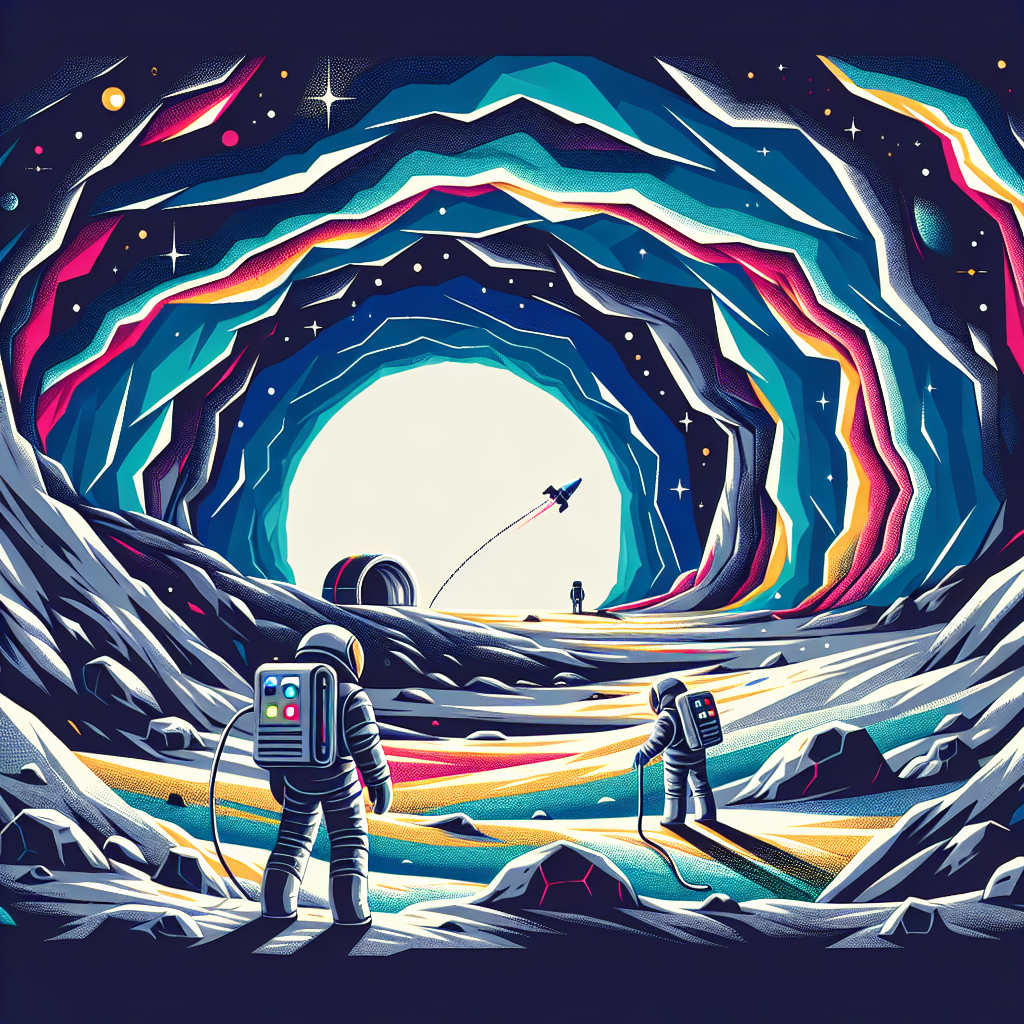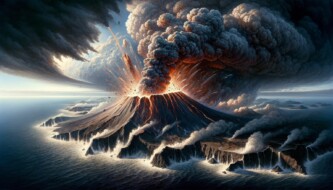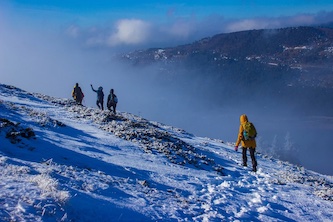A recent discovery has revealed the existence of a cave on the Moon, marking a significant milestone in lunar exploration. This cave, which is estimated to be at least 100 meters deep, presents an intriguing possibility for establishing a permanent human base on the lunar surface. Researchers believe that this cave is just one of potentially hundreds hidden within an “underground, undiscovered world” on the Moon. As various countries compete to establish a sustained human presence on the Moon, the need for protective habitats against radiation, extreme temperatures, and adverse space weather becomes increasingly critical.
Helen Sharman, the first British astronaut to travel to space, expressed optimism about the cave’s potential as a base for future lunar habitation. She suggested that humans could feasibly live in these lunar caves within the next two to three decades. However, she noted that the cave’s depth may pose challenges for astronauts, who might need to use specialized equipment such as jet packs or lifts to navigate in and out of the cave. This highlights the complexities of lunar exploration and the innovative solutions that will be necessary for successful human habitation.
The cave was discovered by researchers Lorenzo Bruzzone and Leonardo Carrer from the University of Trento in Italy, who utilized radar technology to investigate a pit located on the Mare Tranquillitatis, a rocky plain that is also the site of the historic Apollo 11 landing in 1969. The cave features a skylight on the surface, leading to vertical walls and a sloping floor that may extend further underground. The formation of this cave is believed to have occurred millions or even billions of years ago due to ancient lava flows, creating a tunnel-like structure similar to volcanic caves found on Earth, such as those in Lanzarote, Spain.
The researchers are excited about the implications of their discovery, as it opens up new avenues for exploration and understanding of the Moon’s geological history. Prof. Carrer emphasized the significance of being among the first to observe such a unique feature, noting that life on Earth has its origins in caves, suggesting that a similar approach could be viable on the Moon. While the cave has yet to be fully explored, the researchers are optimistic about using advanced technologies, such as ground-penetrating radar and robotic systems, to map its interior.
This discovery not only holds promise for human habitation but also offers valuable insights into the Moon’s history and the broader context of our solar system. The rocks within the cave are likely to be less affected by space weather, preserving a geological record that could date back billions of years. This research, published in the scientific journal Nature Astronomy, may also pave the way for future explorations of caves on Mars, potentially leading to the discovery of evidence of past life on the Red Planet. As the race for lunar exploration continues, the implications of this cave discovery could have far-reaching effects on our understanding of both the Moon and the possibilities for life beyond Earth.
Original news source: Cave discovered on Moon could be home for humans (BBC)
🎧 Listen:
Slow
Normal
Fast
📖 Vocabulary:
| 1 | milestone | A significant stage or event in the development of something |
| 2 | lunar | Relating to the Moon |
| 3 | habitats | Natural environments where organisms live |
| 4 | optimism | Hopefulness and confidence about the future |
| 5 | feasibility | The practicality or possibility of something being accomplished |
| 6 | complexities | The state of being intricate or complicated |
| 7 | innovative | Featuring new methods or ideas; creative |
| 8 | implications | The possible effects or consequences of an action or decision |
| 9 | geological | Relating to the study of the Earth’s physical structure and substance |
| 10 | origins | The point or place where something begins or is created |
| 11 | viable | Capable of working successfully; feasible |
| 12 | preserving | Maintaining something in its original or existing state |
| 13 | context | The circumstances or setting surrounding an event or idea |
| 14 | exploration | The act of traveling through an unfamiliar area to learn about it |
| 15 | implications | The possible effects or consequences of an action or decision |
Group or Classroom Activities
Warm-up Activities:
– CHARADES
Instructions: Students will take turns acting out terms related to the article (e.g., “lunar cave,” “astronaut,” “space weather”) without speaking, while their classmates guess the term. This will help reinforce vocabulary in a fun and engaging way.
– NEWS REPORTER ROLE-PLAY
Instructions: In pairs, students will role-play as news reporters covering the discovery of the lunar cave. One student will present the news, while the other asks questions. This activity will encourage creative thinking and practice in using formal language related to news reporting.
– OPINION POLL
Instructions: Students will discuss the potential of using lunar caves as habitats for humans. They will create a simple poll asking their classmates whether they think living in lunar caves is a good idea or not. After gathering opinions, they will summarize the results and discuss differing viewpoints.
– HEADLINE CREATION
Instructions: Students will work in small groups to create catchy headlines for the article’s main discoveries. They will then share their headlines with the class and explain their choices, focusing on the use of persuasive and engaging language.
– MIND MAP
Instructions: Students will create a mind map on the board that illustrates the various implications of the lunar cave discovery. They will include branches for human habitation, geological history, and potential exploration of other planets like Mars, fostering collaborative brainstorming and critical thinking.
🤔 Comprehension Questions:
1. What significant milestone does the discovery of the cave on the Moon represent in lunar exploration?
2. How deep is the cave estimated to be, and what challenges might this pose for astronauts?
3. Who were the researchers responsible for discovering the cave, and what technology did they use?
4. What geological processes are believed to have contributed to the formation of the cave?
5. In what ways could the cave serve as a protective habitat for humans on the Moon?
6. What potential implications does the cave discovery have for future exploration on Mars?
7. How might the geological record preserved within the cave contribute to our understanding of the Moon’s history?
8. What innovative solutions might be necessary for astronauts to successfully navigate the cave?
Go to answers ⇩
🎧✍️ Listen and Fill in the Gaps:
A recent discovery has revealed the existence of a cave on the Moon, (1)______ a significant milestone in lunar exploration. This cave, which is estimated to be at least 100 meters deep, presents an intriguing possibility for establishing a permanent human base on the lunar surface. Researchers believe that this cave is just one of potentially hundreds (2)______ within an “underground, undiscovered world” on the Moon. As various countries compete to establish a sustained human (3)______ on the Moon, the need for protective habitats against radiation, extreme temperatures, and adverse space weather becomes increasingly critical.
Helen Sharman, the first British astronaut to travel to space, expressed optimism about the cave’s potential as a base for (4)______ lunar habitation. She suggested that (5)______ could feasibly live in these lunar caves within the next two to three decades. However, she noted that the cave’s (6)______ may pose challenges for astronauts, who might need to use specialized equipment such as jet packs or lifts to navigate in and out of the cave. This highlights the complexities of lunar exploration and the innovative solutions that will be necessary for successful human habitation.
The cave was discovered by researchers Lorenzo Bruzzone and Leonardo Carrer from the University of Trento in Italy, who utilized radar technology to investigate a pit located on the Mare Tranquillitatis, a rocky plain that is also the site of the historic Apollo 11 (7)______ in 1969. The cave features a (8)______ on the surface, leading to vertical walls and a sloping floor that may extend further underground. The formation of this cave is (9)______ to have occurred millions or even billions of years ago due to ancient lava flows, creating a tunnel-like structure similar to volcanic caves found on Earth, such as those in Lanzarote, Spain.
The researchers are excited about the implications of their discovery, as it opens up new avenues for exploration and understanding of the Moon’s geological (10)______. Prof. Carrer emphasized the (11)______ of being among the first to observe such a unique feature, noting that life on Earth has its origins in caves, suggesting that a similar approach could be viable on the Moon. While the cave has yet to be fully (12)______, the researchers are optimistic about using advanced technologies, such as ground-penetrating radar and robotic (13)______, to map its interior.
This discovery not only holds promise for human habitation but also offers valuable insights into the Moon’s history and the broader context of our solar system. The rocks within the cave are likely to be less affected by space weather, preserving a geological record that could date back billions of years. This (14)______, published in the scientific journal Nature (15)______, may also pave the way for future explorations of caves on Mars, potentially leading to the discovery of evidence of past life on the Red Planet. As the race for lunar exploration (16)______, the implications of this cave discovery could have far-reaching effects on our understanding of both the Moon and the possibilities for life beyond Earth.
Go to answers ⇩
💬 Discussion Questions:
Students can ask a partner these questions, or discuss them as a group.
1. What is your opinion on the idea of humans living in caves on the Moon?
2. How would you feel if you were chosen to be one of the first astronauts to live in a lunar cave?
3. Do you think establishing a human base on the Moon is a worthwhile investment for countries? Why or why not?
4. What is a significant challenge you think astronauts might face while living in a lunar cave?
5. How do you think living in a lunar cave would differ from living in a habitat on Earth?
6. Do you like the idea of using advanced technologies, like robotic systems, for space exploration? Why?
7. What is a potential benefit of discovering caves on other celestial bodies, like Mars?
8. How would you feel if humans discovered evidence of past life on Mars?
9. Do you think the exploration of the Moon could inspire future generations to pursue careers in science and technology? Why or why not?
10. What is a personal experience you have had that relates to exploration or discovery?
11. How do you think public interest in space exploration has changed in recent years?
12. Do you think international cooperation is essential for the success of lunar exploration? Why or why not?
13. What is a fear you might have about living in an isolated environment like a lunar cave?
14. How would you feel about the possibility of humans altering the Moon’s environment for habitation?
15. Do you think the Moon should be considered a resource for future generations? Why or why not?
Individual Activities
📖💭 Vocabulary Meanings:
Match each word to its meaning.
Words:
1. milestone
2. lunar
3. habitats
4. optimism
5. feasibility
6. complexities
7. innovative
8. implications
9. geological
10. origins
11. viable
12. preserving
13. context
14. exploration
15. implications
Meanings:
(A) The point or place where something begins or is created
(B) The possible effects or consequences of an action or decision
(C) Featuring new methods or ideas; creative
(D) The possible effects or consequences of an action or decision
(E) Hopefulness and confidence about the future
(F) A significant stage or event in the development of something
(G) The state of being intricate or complicated
(H) The circumstances or setting surrounding an event or idea
(I) Relating to the study of the Earth’s physical structure and substance
(J) The practicality or possibility of something being accomplished
(K) The act of traveling through an unfamiliar area to learn about it
(L) Natural environments where organisms live
(M) Maintaining something in its original or existing state
(N) Relating to the Moon
(O) Capable of working successfully; feasible
Go to answers ⇩
🔡 Multiple Choice Questions:
1. What significant discovery has been made on the Moon?
(a) A cave
(b) A new crater
(c) A lunar rover
(d) An alien artifact
2. Who expressed optimism about the cave’s potential for human habitation?
(a) Neil Armstrong
(b) Buzz Aldrin
(c) Helen Sharman
(d) Yuri Gagarin
3. What technology was used to discover the cave on the Moon?
(a) Satellite imaging
(b) Laser scanning
(c) Thermal imaging
(d) Radar technology
4. Which lunar site is mentioned as the location of the cave?
(a) Sea of Serenity
(b) Oceanus Procellarum
(c) Tycho Crater
(d) Mare Tranquillitatis
5. What is one challenge astronauts may face when navigating the cave?
(a) Depth of the cave
(b) Lack of oxygen
(c) High temperatures
(d) Low gravity
6. What geological feature is the cave believed to resemble on Earth?
(a) Ice caves
(b) Volcanic caves
(c) Limestone caves
(d) Sea caves
7. What is the potential benefit of the cave’s rocks for geological studies?
(a) They contain water
(b) They are rich in minerals
(c) They are likely less affected by space weather
(d) They are easy to access
8. What broader implications does the cave discovery have for future explorations?
(a) It could hinder space travel
(b) It may lead to discoveries on Mars
(c) It is unlikely to provide new insights
(d) It will only benefit lunar tourism
Go to answers ⇩
🕵️ True or False Questions:
1. The discovery of the cave may provide insights into the Moon’s geological history and could influence future explorations of caves on Mars.
2. Helen Sharman, the first British astronaut, expressed skepticism about the cave’s potential for future lunar habitation.
3. Researchers believe that there may be hundreds of caves hidden within the Moon’s surface.
4. The cave was discovered by researchers from the University of Trento in Italy using visual examinations.
5. A cave has been discovered on the Moon, which is estimated to be at least 100 meters deep.
6. The cave presents a possibility for establishing a permanent human base on the lunar surface.
7. The formation of the cave is believed to have occurred due to recent erosion over thousands of years.
8. The cave features a skylight and has vertical walls with a flat floor.
Go to answers ⇩
📝 Write a Summary:
Write a summary of this news article in two sentences.
Check your writing now with the best free AI for English writing!
Writing Questions:
Answer the following questions. Write as much as you can for each answer.
Check your answers with our free English writing assistant!
1. What are the potential benefits of establishing a human base in the newly discovered lunar cave?
2. What challenges might astronauts face when navigating in and out of the cave, according to Helen Sharman?
3. How did researchers from the University of Trento discover the cave on the Moon?
4. In what ways could the geological history preserved within the cave contribute to our understanding of the Moon and the solar system?
5. What future explorations could be influenced by the discovery of this lunar cave, particularly concerning Mars?
✅ Answers
🤔✅ Comprehension Question Answers:
1. What significant milestone does the discovery of the cave on the Moon represent in lunar exploration?
The discovery of the cave on the Moon marks a significant milestone in lunar exploration as it presents the possibility for establishing a permanent human base on the lunar surface.
2. How deep is the cave estimated to be, and what challenges might this pose for astronauts?
The cave is estimated to be at least 100 meters deep, which may pose challenges for astronauts who might need to use specialized equipment such as jet packs or lifts to navigate in and out of the cave.
3. Who were the researchers responsible for discovering the cave, and what technology did they use?
The researchers responsible for discovering the cave are Lorenzo Bruzzone and Leonardo Carrer from the University of Trento in Italy, and they used radar technology to investigate a pit located on the Mare Tranquillitatis.
4. What geological processes are believed to have contributed to the formation of the cave?
The cave is believed to have formed millions or even billions of years ago due to ancient lava flows, creating a tunnel-like structure similar to volcanic caves found on Earth.
5. In what ways could the cave serve as a protective habitat for humans on the Moon?
The cave could serve as a protective habitat by offering shielding against radiation, extreme temperatures, and adverse space weather, which are critical for human survival on the Moon.
6. What potential implications does the cave discovery have for future exploration on Mars?
The cave discovery may pave the way for future explorations of caves on Mars, potentially leading to the discovery of evidence of past life on the Red Planet.
7. How might the geological record preserved within the cave contribute to our understanding of the Moon’s history?
The geological record preserved within the cave is likely to be less affected by space weather, which could provide valuable insights into the Moon’s history and geological processes dating back billions of years.
8. What innovative solutions might be necessary for astronauts to successfully navigate the cave?
Innovative solutions such as the use of jet packs, lifts, and advanced technologies like ground-penetrating radar and robotic systems may be necessary for astronauts to successfully navigate the cave.
Go back to questions ⇧
🎧✍️✅ Listen and Fill in the Gaps Answers:
(1) marking
(2) hidden
(3) presence
(4) future
(5) humans
(6) depth
(7) landing
(8) skylight
(9) believed
(10) history
(11) significance
(12) explored
(13) systems
(14) research
(15) Astronomy
(16) continues
Go back to questions ⇧
📖💭✅ Vocabulary Meanings Answers:
1. milestone
Answer: (F) A significant stage or event in the development of something
2. lunar
Answer: (N) Relating to the Moon
3. habitats
Answer: (L) Natural environments where organisms live
4. optimism
Answer: (E) Hopefulness and confidence about the future
5. feasibility
Answer: (J) The practicality or possibility of something being accomplished
6. complexities
Answer: (G) The state of being intricate or complicated
7. innovative
Answer: (C) Featuring new methods or ideas; creative
8. implications
Answer: (B) The possible effects or consequences of an action or decision
9. geological
Answer: (I) Relating to the study of the Earth’s physical structure and substance
10. origins
Answer: (A) The point or place where something begins or is created
11. viable
Answer: (O) Capable of working successfully; feasible
12. preserving
Answer: (M) Maintaining something in its original or existing state
13. context
Answer: (H) The circumstances or setting surrounding an event or idea
14. exploration
Answer: (K) The act of traveling through an unfamiliar area to learn about it
15. implications
Answer: (B) The possible effects or consequences of an action or decision
Go back to questions ⇧
🔡✅ Multiple Choice Answers:
1. What significant discovery has been made on the Moon?
Answer: (a) A cave
2. Who expressed optimism about the cave’s potential for human habitation?
Answer: (c) Helen Sharman
3. What technology was used to discover the cave on the Moon?
Answer: (d) Radar technology
4. Which lunar site is mentioned as the location of the cave?
Answer: (d) Mare Tranquillitatis
5. What is one challenge astronauts may face when navigating the cave?
Answer: (a) Depth of the cave
6. What geological feature is the cave believed to resemble on Earth?
Answer: (b) Volcanic caves
7. What is the potential benefit of the cave’s rocks for geological studies?
Answer: (c) They are likely less affected by space weather
8. What broader implications does the cave discovery have for future explorations?
Answer: (b) It may lead to discoveries on Mars
Go back to questions ⇧
🕵️✅ True or False Answers:
1. The discovery of the cave may provide insights into the Moon’s geological history and could influence future explorations of caves on Mars. (Answer: True)
2. Helen Sharman, the first British astronaut, expressed skepticism about the cave’s potential for future lunar habitation. (Answer: False)
3. Researchers believe that there may be hundreds of caves hidden within the Moon’s surface. (Answer: True)
4. The cave was discovered by researchers from the University of Trento in Italy using visual examinations. (Answer: False)
5. A cave has been discovered on the Moon, which is estimated to be at least 100 meters deep. (Answer: True)
6. The cave presents a possibility for establishing a permanent human base on the lunar surface. (Answer: True)
7. The formation of the cave is believed to have occurred due to recent erosion over thousands of years. (Answer: False)
8. The cave features a skylight and has vertical walls with a flat floor. (Answer: False)
Go back to questions ⇧













